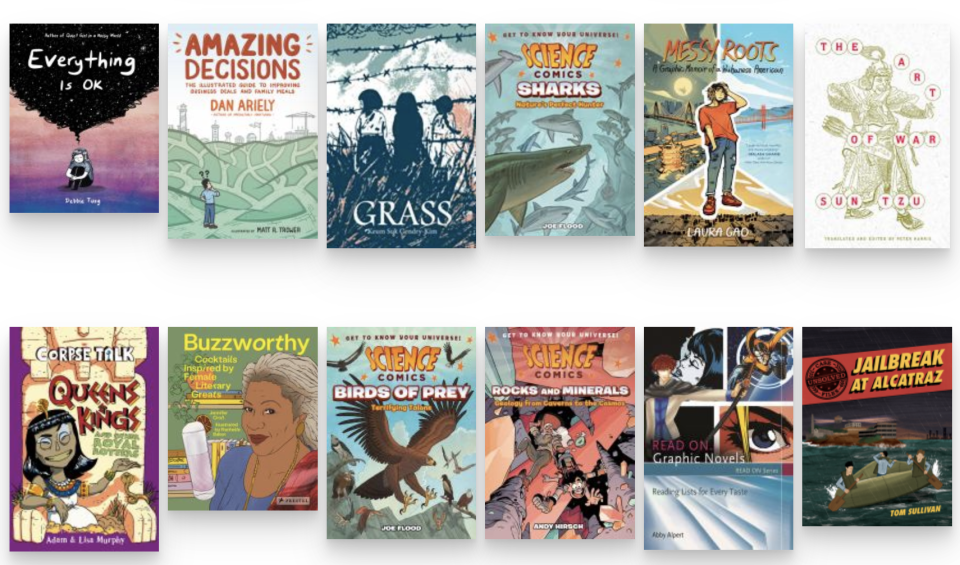10 Reasons to Try (and Love) Graphic Nonfiction Books
Posted on December 20, 2023 at 6:00 am

By Melissa Rhoades
You’ve probably heard the saying “your eyes are bigger than your stomach.” Well, that applies to both my eating and reading habits. I tend to gather far more books than I have time to read. As the book stacks grow in my house, so does my sense of defeat and inadequacy.
I recently discovered nonfiction graphic novels, and light has begun to appear at the end of my reading tunnel.
Because all graphic books are categorized as graphic novels, some people may not realize nonfiction options exist on the graphic novel shelves. But they do!
Fictional graphic novels and manga often focus on fast-paced superhero (or antihero) stories full of action. I tend to prefer literary writing that focuses on character development, language craft, and thought-provoking complexities.
What I’ve discovered is that graphic nonfiction books offer a combination of a fast pace with thoughtful content. This makes them attractive for a wide readership.
One graphic memoir I recently read took only one and a half hours to complete. That’s less time than it takes to watch some movies. And yet, within that short span of time, my understanding of the world expanded through learning about another individual’s experiences.
At our libraries, we shelve nonfiction graphic titles at the end of our graphic novel sections. You’ll be able to distinguish them because they have Dewey Decimal numbers on their spines in addition to a word or name.
10 Great Reasons to Read Nonfiction Graphic Novels
If you’ve avoided—or simply didn’t know about—the graphic novel section at your local library, I encourage you to peruse the shelves and give graphic nonfiction titles a try. Here are some reasons why.
- If you’re lagging on your 2023 reading goals, graphic nonfiction offers quick reads that help you catch up in no time.
- If you’re a reluctant reader, you can find quick-to-engage books that don’t bog you down.
- If you’re a “serious” reader, you can find topics hefty enough to satisfy cravings for complex ideas.
- For readers who love action, even nonfiction graphic novels offer a fast pace.
- If you’re in a reading slump, graphic novels can ease you back into a regular reading practice (precisely because they are rapid reads).
- Graphic books help readers develop visual literacy—the ability to understand and interpret nonverbal imagery. This skill is becoming increasingly vital in our information age.
- Graphic books can make complex ideas easier to understand through the addition of visual elements.
- Because illustrations add context clues that aid comprehension, graphic books can be more approachable than traditional texts for people with learning difficulties or diagnosed learning disabilities.
- Graphic nonfiction provides a great way to explore new topics without having to slog through dense volumes of text that are difficult to absorb.
- Graphic nonfiction expands your understanding of the world. You can quickly learn about history, current events, people, how-to topics, and more.
A bonus 11th benefit of graphic nonfiction books is that they’re available for all ages!
Parents and caregivers who are leery of children spending too much time reading graphic novels can breathe a sigh of relief. Researchers have discovered benefits to reading graphic books even for advanced young learners.
The following lists of nonfiction graphic novels shows some of the titles available from the library for different age groups.

Adult Graphic Nonfiction
Grand Theft Horse, written by Coretta Scott King Award Honor winner Greg Neri and illustrated by Corban Wilkin, recounts the true story of a courageous horse trainer who took it upon herself to steal a beloved racehorse that was being abused by the racing system for profit.
A History of Japan in Manga, by Shunichiro Kanaya and translated by Zack Davisson, packs an action punch with fully illustrated scenes, maps, and info graphs that span Japanese history from the days of the samurai to World War II.
Pinball: A Graphic History of the Silver Ball, by Jon Chad, and The Song of the Machine: From Disco to DJs to Techno, a Graphic Novel of Electronic Music, by David Blot and Mathias Cousin (with an introduction by Daft Punk), are just two of several pop-culture histories available on our graphic novel shelves.
Brief Histories of Everyday Objects, by Andy Warner, offers two-minute chapters recounting the stories behind dozens of inventions we take for granted today. Full of humor and wit, this quick read covers the histories of objects including toilets, traffic lights, and Tupperware®.
They Called Us Enemy, written by George Takei and illustrated by Harmony Scott, recounts Takei’s experiences as a Japanese American child imprisoned in an American concentration camp during World War II. Readers discover not only an undertaught part of American history but also the charm, resilience, and emotional intelligence of the boy who became a famous actor and activist.
Making Comics, by Lynda Barry, provides a full, self-paced drawing class you can complete on your own. Barry’s signature style comes from championing process over product and allowing that process to come from a receptive state of mind.
The Talk, by Pulitzer-Prize winning editorial cartoonist Darrin Bell, starts when Bell is six years old and receives the talk from his mom about the dangers of living in a Black male body. The memoir thoughtfully covers Bell’s formative years to adulthood. It culminates when he realizes it’s time to give his version of the talk to his oldest son.
The Times I Knew I Was Gay, by Eleanor Crewes, is a sweet and relatable memoir about adolescence and young adulthood. It recounts one woman’s growing pains as she struggles through her teens and early twenties to discover why dating boys never felt right.
A myriad of graphic biographies about famous individuals are also available. A few examples include:
- Anne Frank’s Diary: The Graphic Adaptation
- Bowie: An Illustrated Life
- James Brown: Black and Proud
- Alexander Hamilton: The Graphic History of an American Founding Father
- Billie Holiday: The Graphic Novel
Let’s Make Dumplings!: A Comic Book Cookbook, written by chef Hugh Amano and illustrated by Sarah Becan, gives readers a mouth-watering how-to graphic recipe book. Along with history and lore about this delicious and well-loved food, you will find recipes with illustrated step-by-step instructions.

Teen Graphic Nonfiction
In the Shadow of the Fallen Towers, by Don Brown, describes to a new generation the terror of what happened in New York City on September 11, 2001, as well as related events that unfolded in the following 12 months.
Across the Tracks: Remembering Greenwood, Black Wall Street, and the Tulsa Race Massacre,written by Alverne Ball and illustrated by Stacey Robinson, was created as a love letter to Greenwood, Oklahoma. This African American community prospered before being terrorized by a massacre in 1921.
Almost American Girl: An Illustrated Memoir, by Robin Ha, follows her life as a Korean girl who becomes devastated when her vacation to the United States turns into permanent residency. She is thousands of miles away from her friends and everything she knows. Then, something begins to make her life better.
Change the Game, a memoir by Colin Kaepernick, Eve L. Ewing, and Orlando Caicedo, focuses on Kaepernick’s coming of age story, especially events that inspired his activism as an adult.
83 Days in Mariupol: A War Diary, by Don Brown, uses a compassionate eye to bring to life recent events from the current war in Ukraine.
Our Stories Carried Us Here: A Graphic Novel Anthology, edited by Julie Vang, Tea Rozman, and Tom Kaczynski, offers first-person accounts from people who fled harmful situations in search of better lives. Each story is created by a different author-illustrator team, showcasing a variety of graphic styles.
What Does Consent Really Mean?, written by Pete Wallis and Thalia Wallis and illustrated by Joseph Wilkens, explores the concept of sexual consent in depth through conversations teens hold with each other.
Wonderful Women of the World, published by DC Comics and edited by Laurie Halse Anderson, introduces readers to real heroic women in science, sports, activism, diplomacy, and more. Each woman’s story is authored and illustrated by a different team, offering another anthology with many graphic styles.

Children’s Graphic Nonfiction
The following options are all series created for kids.
Graphic Survival Stories offer great nonfiction options for kids who love adventure.
Jr. Graphic Mythologies recount stories from world mythology (also full of action).
Who HQ Graphic Novels are companions to the biographical Who Was? chapter books.
Science Comics provide comic-book-style narratives chock full of serious scientific concepts and vocabulary.
Maker Comics offer how-to graphic books for kids.
The Big Ideas that Changed the World series focuses on the history of science and major achievements in STEM.
Earth Before Us books introduce young readers to prehistoric animals and biological concepts like evolution.
Famous Firsts: Animals Making History includes great true stories for kids who love tales about animals.
Illustrated History: Eye on History books take children on journeys through historical moments in American history.
Pictures Worth a Thousand Words
Technology has expanded the ways we absorb information in our daily lives, from the rise of email in the 1990s to today’s proliferation of social media outlets, podcasts, streaming services, and digital books. The increasing availability of graphic novels (including graphic nonfiction) is part of this changing landscape.
In fact, many of our graphic offerings are available as eBooks and digital audiobooks in addition to print.
Whatever format you choose, graphic nonfiction offers thoughtful, informative content that is quick to read, easy to absorb, artfully illustrated, and full of fascinating people, action, and ideas. Enjoy!

Melissa Rhoades fulfilled a childhood dream when she started her first library position in 2016. As a Public Services Specialist at Spokane County Library District, she presents weekly storytimes, hosts programs, works on the 3D printing team, writes on the blog team, assists with collection maintenance, and tends the reference desk, among other tasks. Off the clock, she enjoys exploring the arts and the natural beauty of the Pacific Northwest.
Tags: adults, booklists, books, graphic novels, history, illustration, illustrations, kids, memoir, nonfiction, parents, reading, teens
